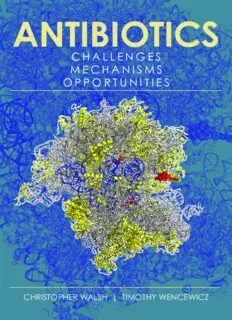
Antibiotics: Challenges, Mechanisms, Opportunities PDF
Preview Antibiotics: Challenges, Mechanisms, Opportunities
ANTIBIOTICS CHALLENGES WALSH ANTIBIOTICS WENCEWICZ MECHANISMS OPPORTUNITIES A A chemocentric view of the molecular structures of antibiotics, their origins, actions, and major categories of resistance C H A L L E N G E S N Antibiotics: Challenges, Mechanisms, Opportunities focuses on antibiotics as small organic molecules from both natural and synthetic sources. Understanding the chemical scaffold and functional group structures of M E C H A N I S M S the major classes of clinically useful antibiotics is critical to understanding how antibiotics interact selectively with bacterial targets. T This textbook details how classes of antibiotics interact with five known robust bacterial targets: cell wall O P P O R T U N I T I E S I assembly and maintenance, membrane integrity, protein synthesis, DNA and RNA information transfer, and the folate pathway to deoxythymidylate. It addresses the universe of bacterial resistance, from the concept B of the resistome to the three major mechanisms of resistance: antibiotic destruction, antibiotic active efflux, and alteration of antibiotic targets. Antibiotics also covers the biosynthetic machinery for the major classes of I natural product antibiotics. O Authors Christopher Walsh and Timothy Wencewicz provide compelling answers to these questions: • What are antibiotics? • Where do antibiotics come from? T • How do antibiotics work? • Why do antibiotics stop working? I • How should our limited inventory of effective antibiotics be addressed? C Antibiotics is a textbook for graduate courses in chemical biology, pharmacology, medicinal chemistry, microbiology, and biochemistry. It is also a valuable reference for microbiologists, biological and natural product chemists, pharmacologists, and research and development scientists. S “ This book provides all the information needed to understand antibiotic genetics, biochemistry, OMC mechanism of action, and resistance. Most importantly, Walsh and Wencewicz are optimistic of the prospects of the discovery of novel therapeutic agents obtained by the manipulation PEH PCA of strains and biosynthetic pathways. This beautifully written book deserves to be read and OHL implemented by everyone, especially the pessimists who believe that the antibiotic era has RAL ended. In Antibiotics: Challenges, Mechanisms, Opportunities Walsh and Wencewicz provide E the definitive, ultimate compendium of everything antibiotic.” TUNN -- Julian Davies, Professor of Microbiology and Immunology, NISG Life Sciences Institute, University of British Columbia, Vancouver IME T ISS E S Christopher Walsh is a Harvard Timothy Wencewicz is a Medical School professor emeritus faculty member in the who serves as a senior advisor to Department of Chemistry the ChEM-H Center at Stanford at Washington University University. He has authored hundreds in St. Louis. After receiving of papers and books, including the his Ph.D. at the University predecessor to this title, Antibiotics: of Notre Dame, he was Actions, Origins, Resistance (2003). a postdoctoral fellow in Dr. Walsh is a member of the U.S. National Academy Christopher Walsh’s laboratory at the Harvard of Sciences, the U.S. National Academy of Medicine, Medical School. Dr. Wencewicz’s research the American Academy of Arts and Sciences, and the centers on antibiotic drug discovery, natural American Philosophical Society and a co-recipient of product biosynthesis, and targeted drug the 2010 Welch Prize in Chemistry. delivery across bacterial membranes. ISBN 9781555819309 90000 > CHRISTOPHER WALSH | TIMOTHY WENCEWICZ 9 781555 819309 Coverillustration:Snapshotofthe70SE.coliribosome(PDBfor50Sis2WDL;PDBfor30SandtRNAsis2WDK) boundtothreeclassesofantibiotics.ThefigureshowsRNA(gray)andprotein(yellow)componentsoftheribosome withassociatedtRNAsshownasbluecartoonsandboundantibioticsshownasredspacefillingspheres.Theterpenoid tiamulinQ23bindstothe23SrRNAatthepeptidyltransferasecenter(PDB1XBP).Thenonribosomalpeptide viomycinbindsattheinterfaceofthe50Sand30SsubunitsatthetRNAAsite(PDB4V7L).Thethiazolylpeptide thiostreptonbindsattheperiphery,interactingwithaspecificpairof23SrRNAhelicesandaproline-richregionof theL11proteinsubunit(PDB3CF5).(ImagecreatedusingPyMOL.) Copyright©2016AmericanSocietyforMicrobiology.Allrightsreserved.Nopartofthispublicationmaybe reproducedortransmittedinwholeorinpartorreusedinanyformorbyanymeans,electronicormechanical, includingphotocopyingandrecording,orbyanyinformationstorageandretrievalsystem,withoutpermissionin writingfromthepublisher. Disclaimer:Tothebestofthepublisher’sknowledge,thispublicationprovidesinformationconcerningthesubject mattercoveredthatisaccurateasofthedateofpublication.Thepublisherisnotprovidinglegal,medical,orother professionalservices.Anyreferencehereintoanyspecificcommercialproducts,procedures,orservicesbytradename, trademark,manufacturer,orotherwisedoesnotconstituteorimplyendorsement,recommendation,orfavored statusbytheAmericanSocietyforMicrobiology(ASM).Theviewsandopinionsoftheauthor(s)expressedinthis publicationdonotnecessarilystateorreflectthoseofASM,andtheyshallnotbeusedtoadvertiseorendorseany product. LibraryofCongressCataloging-in-PublicationData Names:Walsh,Christopher,author.|Wencewicz,TimothyA.,author. Title:Antibiotics:challenges,mechanisms,opportunities/byChristopher T.WalshandTimothyA.Wencewicz. Description:Washington,DC:ASMPress,[2016]|?2016|Includes bibliographicalreferencesandindex. Identifiers:LCCN2015045498(print)|LCCN2015047879(ebook)|ISBN 9781555819309(hardcover)|ISBN9781555819316() Subjects:LCSH:Antibiotics.|Drugresistanceinmicroorganisms. Classification:LCCRM267.W3582016(print)|LCCRM267(ebook)|DDC 615.3/29–dc23 LCrecordavailableathttp://lccn.loc.gov/2015045498 AllRightsReserved PrintedintheUnitedStatesofAmerica 10 9 8 7 6 5 4 3 2 1 AddresseditorialcorrespondencetoASMPress,1752NSt.,N.W., Washington,DC20036-2904,USA SendorderstoASMPress,P.O.Box605,Herndon,VA20172,USA Phone:800-546-2416;703-661-1593 Fax:703-661-1501 E-mail:[email protected] Online:http://www.asmscience.org . Dedicated by CTW to Diana, Allison, Thomas, and Sean . Dedicated by TAW to Rachel, Grace, and Lucy Contents Preface ix–x Section I ChallengesforAntibiotics 1 1 Antibiotics:InitialConceptsandConsiderations 4 2 MajorClassesofAntibioticsandTheirModesofAction 16 Section II Mechanisms:AntibioticActionbyBacterialTargetClass 33 3 AssemblyofthePeptidoglycanLayerofBacterialCellWalls 36 4 AntibioticsThatBlockPeptidoglycanAssemblyandIntegrity 68 5 AntibioticsThatDisruptMembraneIntegrity 102 6 AntibioticsThatBlockProteinSynthesis 114 7 AntibioticsThatTargetDNAandRNAInformationTransfer 148 8 AntibioticsThatBlockBiosynthesisoftheDNABuilding BlockDeoxythymidylate 164 SectionIII Mechanisms:BacterialResistancetoAntibiotics 177 9 BacterialAntibioticResistance:Overview 180 10 AntibioticResistance:ModificationorDestructionoftheAntibiotic 198 11 AntibioticResistanceviaMembraneEffluxPumps 220 12 ResistanceviaTargetModification 230 13 Tuberculosis:AFormidableChallengeforAntibioticTherapy 252 vii viii | CONTENTS SectionIV Mechanisms:AntibioticBiosynthesis 273 14 AntibioticBiosynthesis:Principles 276 15 BiosynthesisofPeptideAntibiotics 288 16 BiosynthesisofPolyketideAntibiotics 320 17 BiosynthesisofOligosaccharide,Isoprenoid,and C-PAntibioticClasses 344 Section V Opportunities 363 18 UnderexploitedPathwaysandTargetsforAntibiotics 366 19 ProspectsforNewMoleculesandNewTargets 398 References 421 Index 455 Preface Overthepastdecade,manylinesofevidencehavecometogethertoemphasizethecriticalneedfor newantibioticstotreatbacterialpathogens.Theserealizationshavegalvanizedthescientificcom- munity as well as the global citizenry more generally. Infectious disease groups, government- appointed expert panels,highpolitical officials, and the popular press have noted the prospect of life-threateningbacterialinfectionstriggeringglobalsocietalcrises. Therehasbeenaparallelrealizationandsetofeffortsseekingnewantiviraltreatmentsaspoten- tiallyglobalepidemicsarise.Historically,antiviraldrugsandantibacterialdrugshavebeendiscov- eredanddevelopedessentiallyindependentlywithalmostnocrossovertargetsorbenefits.Viruses tend to be targeted by small molecules that block nucleic acid replication and inhibit proteases needed to cut viral polyproteins into functional subunits; these approaches have not readily been reframedforusefulantibacterials.Thisbookthendealsonlywithantibacterialagents,antibiotics, andnotantivirals;albeittheneedforacontemporaryintegratedsummaryispressing. Theneedfornext-generationversionsofantibioticsisnotnew.Thiswasthemotivationinwriting aprecursortothisbookin2003:Antibiotics:Actions,Origins,Resistance.Ithasbeentrueforevery class of antibiotic introduced into wide human clinical use since the antibiotic era began in the 1930sthatresistantorganismsareselectedforandeventuallybecomeabundantinhumaninfections. Others have noted, appropriately, the complexity of the cycles of development of antibiotics, developmentofresistance,andneedfornewantibiotics.Theneedforconservationandprolongation ofusefullifetimesoftheexistingantibioticsportfoliohasbothhealthandeconomicconsequences. Marketincentivesoverthepast2decadeshavebeenviewedasinsufficientforlargepharmacom- paniestoinvestinantibioticsresearch.Alternativestotraditionalsmall-moleculeantibioticsrange from vaccines with a preventative role to biologics, whetherantibodies or lytic phage treatments, buttheuseofthesetherapieshasnotyetbecomewidespread. Amidthissetofcomplexities,oneconstantisthatnewantibioticsarealwaysneededtodealwith wavesofresistantbacteriathatbecomeinuredtoanyantibioticclassthatiswidelydisseminatedfor treatment.Givenourbeliefthatnewclassesofantibioticsareacutelyneededtofillthefrontendofthe antibioticcycles,theapproachinthismonograph,Antibiotics:Challenges,Mechanisms,Opportunities, ischemocentric. Thechallengesaremanyandlayered,asnotedinpassingabove,butchiefamongthemishowto findnewmolecules,whetherthroughthediscoveryofnovelvariantsfromnatureorthecreativityof ix
